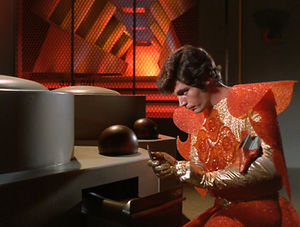Difference between revisions of "Warp core"
| Line 13: | Line 13: | ||
Warp core safety systems, especially aboard [[Galaxy-class|''Galaxy''-class]] [[starship]]s, are prone to failure themselves. Systems designed to shut down the reactor in an emergency routinely fail, and the warp core ejection system -- a last-ditch option that launches the entire core into space -- has also repeatedly failed to operate when needed. | Warp core safety systems, especially aboard [[Galaxy-class|''Galaxy''-class]] [[starship]]s, are prone to failure themselves. Systems designed to shut down the reactor in an emergency routinely fail, and the warp core ejection system -- a last-ditch option that launches the entire core into space -- has also repeatedly failed to operate when needed. | ||
For example, see the [http://www.youtube.com/watch?v=lW7YPKfGewI&feature=related destruction of the ''Enterprise''] in [[TNG]] "Cause and Effect". Note that both of the "failsafe" systems to prevent the destruction of the ship fail: both an emergency shutdown of the warp core and an emergency ejection of the warp core. | For example, see the [http://www.youtube.com/watch?v=lW7YPKfGewI&feature=related destruction of the ''Enterprise''] in [[TNG]] "Cause and Effect". Note that both of the "failsafe" systems to prevent the destruction of the ship fail: both an emergency shutdown of the warp core and an emergency ejection of the warp core. Likewise, in ''[[Star Trek: Generations]]'', neither the shutdown nor the ejection system works, and the crew is forced to evacuate the [[engineering section]] and separate it from the [[saucer section|saucer]] before it explodes (even then, the blast damages the saucer and causes it to crash). | ||
===Incidents=== | ===Incidents=== | ||
Revision as of 18:48, 3 December 2013


A warp core is a matter-antimatter reactor used to provide power for starships in Star Trek. Its primary purpose is to provide power for the warp drive, but "warp power" is also used to supply many other systems.
Nature
Inside a warp core, matter and antimatter are allowed to contact and annihilate each other within a magnetic containment field. Dilithium crystals are used to control the reaction, and their orientation affects the efficiency of the reaction.[1] Energy from the reaction is collected in the form of plasma and piped around the ship to power various systems, especially the warp drive.

Hazards
Warp cores are prone to excess reactivity, making them incredibly dangerous to operate. When operating, a warp core typically contains enough antimatter to destroy its ship if the magnetic field isolating the fuel from the containment vessel should fail.
Warp core safety systems, especially aboard Galaxy-class starships, are prone to failure themselves. Systems designed to shut down the reactor in an emergency routinely fail, and the warp core ejection system -- a last-ditch option that launches the entire core into space -- has also repeatedly failed to operate when needed.
For example, see the destruction of the Enterprise in TNG "Cause and Effect". Note that both of the "failsafe" systems to prevent the destruction of the ship fail: both an emergency shutdown of the warp core and an emergency ejection of the warp core. Likewise, in Star Trek: Generations, neither the shutdown nor the ejection system works, and the crew is forced to evacuate the engineering section and separate it from the saucer before it explodes (even then, the blast damages the saucer and causes it to crash).
Incidents
- Enterprise, NX-01; destroyed in alternate timeline by a deliberate core breach
- Enterprise, NX-01 (Mirror Universe); destroyed in battle due to a jammed AM ejection system
- USS Enterprise, NCC-1701-D; destroyed multiple times in various timelines, permanently destroyed by core breach in Star Trek: Generations.
- USS Enterprise, NCC-1701-E; this breach was remotely triggered after core ejection
- USS Yamato; destroyed by an AM containment failure (TNG "Contagion")
- Farrakk's starship; sabotaged
- USS Orinoco; sabotaged
References
- ↑ TNG "Booby Trap"